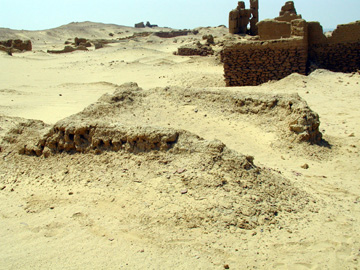

 |
When I first came to the University of Michigan, I was constantly amazed by the vast number of Roman sandals housed upstairs in the Kelsey Museum SAFE. Ruminations on ancient footwear and drawers of rope have led me to study a number of Kelsey artifacts over the past few years. In recent months, I have been studying artifacts in the collection that relate to ancient magic at the site of Karanis, a Graeco-Roman site located southwest of Cairo, Egypt, and excavated by the University of Michigan between 1924 and 1935. This study would only be possible in the Kelsey Museum, where all of the records from the Karanis excavations are housed. Robin Meador-Woodruff, Associate Curator of Slides and Photos, and Kate Carras, Assistant Registrar, have graciously helped me as I read through ten volumes of the records of objects for Karanis, looked at the photographs from the site, and investigated the artifacts that are in the Museum. The Kelsey Museum houses more than 45,000 objects from Karanis, but this large figure does not include all of the finds. Following the completion of the excavation, the Egyptian government and the University of Michigan made a division of all of the artifacts, and many pieces I wanted to see are now in the Egyptian Museum. So I was off to Cairo!
Dr. Janet Richards, Assistant Curator for Dynastic Egypt, had warned me that obtaining access to the collections of the Egyptian Museum is not an easy task. As luck would have it, however, the ceramicist from the Kelsey Museum’s Abydos excavations, J. J. Shirley, was working in Egypt at the same time, and she introduced me to her friend Adel Mahmoud, Curator of the New Kingdom Collections at the Egyptian Museum. Mr. Mahmoud was very helpful; he not only provided me with a pass to get into the museum but also assisted me in locating the Karanis objects that I had hoped to see. Because all of the records in the Kelsey are crosslisted with records in Cairo, this was easier than I had expected. I had access to the pieces currently on display, as well as a number of objects in the storerooms. The basement of the Egyptian Museum bears little resemblance to that of the Kelsey! Hundreds of mummy cases, thousands of lamps, and tons of pottery of all shapes and sizes line the walls. It was difficult to find my twenty objects among the millions! As thanks for his help, I gave Mr. Mahmoud a catalogue from Dr. Thelma Thomas’s recent exhibition, “The Fabric of Everyday Life: Textiles from Karanis, Egypt.”
After spending a number of days in the museum, I headed out to the site of Karanis itself to locate the buildings and areas where the objects had been found. Armed with site plans, a compass, and a large hat, I was able to locate many of the buildings, but some of the structures in which I was interested had been removed in the subsequent years of the University’s work on the site. Francis W. Kelsey chose an amazing site to dig, and the remains are still quite visible, despite seventy years of blowing sand. If you go in the summer, though, I would strongly suggest taking several bottles of water!
Drew Wilburn
IPCAA Ph.D. candidate
Copyright © 2002 The Kelsey Museum of Archaeology, University of Michigan. All rights reserved.